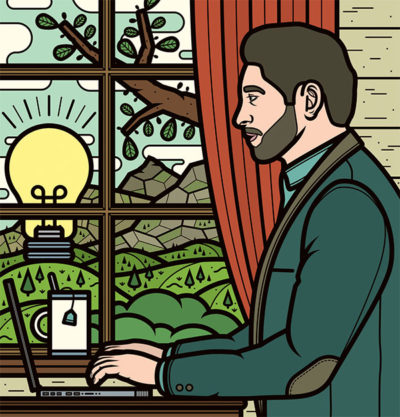
Christopher Queitsch ’09 sells office supplies, everything from clipboards and copy paper to calculators and coffee. He’s the co-founder of online retailer OfficeRock.com, essentially a Staples or Office Depot for the United Arab Emirates. Based in Dubai, the company launched its successful website in 2015.
Queitsch knows that his business isn’t unique. “I’m not the first person to make a website with products online,” he says. Queitsch acknowledges that his products aren’t novel either. “Who you buy a pen from doesn’t matter for the customer,” he says. “It’s the same pen.”
For that reason, Queitsch thinks seriously about innovation. Looking to set the company apart, he constantly listens to the needs of his customers and suppliers and seeks inventive ways to refine the business, making improvements to its inventory management and the consumer experience of its website. The company may sell pens and paperclips, everyday items that can be found in a multitude of stores, but Queitsch wants shopping at OfficeRock.com to be easier and better than elsewhere. “Without innovation, we’re the same as everyone else,” Queitsch says.
But innovation doesn’t come easy. Smart business ideas, as Queitsch knows, don’t just happen. They take effort. To kindle creativity means bringing a thoughtful and deliberate approach to one’s work. “Innovation is a discipline,” says professor Jay Rao, who has worked at Babson for 22 years and teaches courses on innovation and strategy. “You can learn it, you can practice it, you can master it. It’s not magic. It’s not luck.”
FEEDING CREATIVITY
The need for innovation and creativity cuts across fields, whether you work at an architectural firm or an accounting firm, a tech giant or a tech startup, a vast corporation or a one-man shop. “Any business has to be creative to be relevant,” says Erica Zahka, MBA’16, founder and owner of Own The Boardroom. “It’s not only Apple.”
Based in Norwood, Massachusetts, Own The Boardroom serves as an on-demand professional closet, allowing customers to rent men’s and women’s attire for job interviews and business meetings. Zahka launched the venture late last year. She admits that the hectic life of a startup doesn’t always allow for the time or energy to come up with imaginative business strategies. If a problem arises, the best option is sometimes to “duct tape it” and move on. “Depending on the impact of the problem, ‘done’ is often better than ‘perfect’ in the startup world,” she says.
But one way Zahka finds inspiration is in the company of other entrepreneurs. She’s a recent participant in Babson’s Women Innovating Now Lab in Boston. In May, she won the lab’s Breakthrough Women’s Entrepreneurial Pitch Competition. “I am a huge advocate of WIN Lab,” Zahka says. “Being surrounded by people who are dedicated and passionate—it’s very energizing and motivating.”
Every Wednesday evening during the eight-month venture-accelerator program, she and her cohorts met to hear presentations and talk about their businesses. Problems were shared and suggestions were offered. Feedback flowed. “A lot of timesit was difficult to go to bed on Wednesday evenings,” Zahka says. “You had so much energy and so many ideas. You wanted to start working on something right then.” Her WIN Lab experience is now over, but Zahka still gathers with members of her cohort to chat about the highs and lows of their entrepreneurial journeys. “It’s always helpful,” she says.
Daniel Thomsen ’02 also relies on feedback from others. Thomsen is a TV writer, a career he decided to pursue after the collapse of the dot-com bubble forced him to reconsider his original plan, which was to join a tech startup after graduation. Driven by his passion for writing, he moved to Los Angeles and slowly but surely built a career. Through the years, he has written for a variety of TV shows, including Westworld, Once Upon a Time, Time After Time, Terminator: The Sarah Connor Chronicles, and a Melrose Place remake.
When working on a script, Thomsen doesn’t have the luxury of waiting around for inspiration to strike. “You’re working in an environment with 150 to 200 people who are waiting for your script pages to appear before they can do their jobs,” says Thomsen. “As motivation goes, that’s fairly compelling.”

If Thomsen has script trouble, he turns to his fellow writers to help kick-start his creativity. “The most effective way to help a fellow writer is to listen,” he says. “Professional writers are very good at describing, sometimes in painful detail, the problems they’re having with a story.” Thomsen will sit down with the show’s other writers and hash out his script’s headaches. What’s missing? What’s getting in the way of a satisfying ending? Soon enough, people pitch solutions. Ideas fly, one on top of the other. “Just hearing another person’s spin on something, especially if they’re building on what you’re creating in a fresh or unexpected way, is inspiring,” he says.
Thomsen also absorbs insights and inklings from other sources—books, movies, the people he meets, the world around him. “If creativity is your output, you have to keep feeding your brain withnew and exciting input,” he says. “Then it’s up to you to take what you’re thinking about or feeling, and channel it into something useful.”
If he is really stuck, Thomsen changes his location. When the last script he wrote wasn’t clicking, Thomsen drove to Lake Arrowhead, a mountain town about two hours outside L.A. “Two nights in a completely different climate, around totally different people, and it jogged my brain to start thinking about my story problems from a new angle,” he says.
This strategy, of changing locales and getting away from routines and familiar surroundings, is an effective one, says professor Rao. Some companies try this tactic with their employees. One Southern California communications firm, for instance, gives its employees $1,500 every year to travel anywhere in the world and explore, says Rao. A Cleveland medical center, meanwhile, requires senior staff members to take time each year and observe operations in an industry unrelated to medicine. By experiencing something new, says Rao, employees are forced to look at the world differently. “The more they get out of their comfort zone, the more they observe and listen and question the status quo in their own businesses,” he says.
EMBRACING LIMITATIONS
When Ed Nilsson, MBA’97, needs to feel inspired, the architect doesn’t travel far. Founded in 1981, his firm, Nilsson + Siden Associates, works on renovations and new construction, designing such projects as office buildings, town halls, single-family residences, and medical offices.
While Nilsson says some architects return to Italy every year to recharge their imaginations, he simply strolls around town. He lives in Marblehead, Massachusetts, and his firm is located in nearby Salem. Walking around these two historic seaside towns, Nilsson seeks a fresh perspective, not by checking out contemporary architecture, but by looking to the past. Architects like him are perpetual students. “We’re always looking forward, but we also look backward,” Nilsson says. “Some people say it takes 50 years to learn this profession.” He finds that many modern buildings, designed with the aid of computer software, are too slick, too flawless. He likes the charm of the old buildings, how they’re a bit quirky and not always perfect. “The human touch is always evident,” he says.

When designing a project, Nilsson often faces constraints. Maybe the construction budget is small, or maybe he has to renovate a historic building and preserve as much of its character as possible. At this point, the key is not to fight the constraints, but to embrace them. Nilsson believes the process of working through limitations makes his designs stronger. “It makes you think sharper, clearer,” he says. “If you need something to make you think outside the box, constraints will do that.”
Years ago, he took on a project to convert a 19th-century machine shop at Boston’s Charlestown Navy Yard into apartments. An earlier design by other architects proposed to fill the 500,000-square-foot building with spacious units, but when that proved too costly, Nilsson reconfigured the design. He scaled down the size of the apartments and preserved most of the open space in the center of the building as a landscaped atrium, taking advantage of the structure’s existing skylights. The end result met the budget and was a much more pleasing design, says Nilsson.
Similarly, TV writer Thomsen often finds his scripts must meet real-world parameters. “At the very beginning of the writing process in television, we call it the ‘blue sky’ phase, where there are fewer limits on what you can write,” he says. Then the budget arrives, and Thomsen becomes locked into certain locations or a particular number of cast members. He may later find out that an ambitious visual effect he wanted can’t be pulled off. “Suddenly your writing is being guided by dozens of factors,” he says. This requires a switch in mindset, as he becomes less like a writer with a story to tell and more like a problem solver with a puzzle to figure out.
For creators and doers in need of solutions and inspiration, professor Rao says they shouldn’t fret about taking someone else’s idea and adapting it for their own use. Don’t aim for 100 percent originality, he advises. “Real entrepreneurs don’t care for that. They don’t care for uniqueness. They look for an opportunity,” he says. “Shakespeare stole like crazy. Walt Disney borrowed ideas heavily and so did Steve Jobs.”
When she was putting together Own The Boardroom, Zahka looked closely at Rent the Runway, a service that allows customers to rent designer dresses. She put her own spin on the idea, but that business served as a model for what she wanted to do. “Whatever the situation is at hand, it’s always helpful to find an example where it appears to be working smoothly,” Zahka says. “Reinventing the wheel all the time is not efficient.”
One industry certainly not afraid to copy a good idea is TV. Reboots and remakes are plentiful. “It’s safer to produce entertainment that already has brand awareness built in,” Thomsen says. Original shows, even hits such as Breaking Bad and Mad Men, can take awhile to build a following. Make a well-known movie like Fargo into a TV show, on the other hand, and more people will check it out from day one. But Thomsen believes that even if writers are working within the confines of an old show or movie, they can still make fresh and innovative television. “I think there’s still plenty of originality to be mined,” he says.
Currently taking time to pursue his own projects, Thomsen has two ideas for shows in studio development, the first about people practicing witchcraft in Las Vegas, the other a castaway family drama, a kind of modern-day Swiss Family Robinson. He’s hoping to hear soon whether either will be greenlit for production, though one challenge with working in TV now is the glut of shows available for viewers. In the so-called era of Peak TV, a great show, no matter how compelling, can easily be overlooked. Thomsen avoids over-analyzing TV viewers. “You can get tied up in knots trying to chase audience expectations,” he says. “I still try to write from a simple place of, ‘What am I interested in watching?’”
CREATING CULTURE
Just like others, Toni Clayton-Hine ’93 is constantly seeking ways to feed her creativity. The senior vice president and chief marketing officer at Xerox, she looks at clever ads and innovative products, no matter the industry they come from, in a search for inspiration. Her mind is always working. “I have 100 ideas every day, and 98 percent of them are terrible,” says Clayton-Hine, who works out of the company’s home base in Norwalk, Connecticut. “It must be the way I’m wired.”

Clayton-Hine takes those ideas to her team and “walks the plank,” so to speak, encouraging staff to poke holes in them. By exposing her ideas to critiques, she is hoping to encourage other team members to bring their thoughts forward as well. “You want them to feel it’s a safe place to come up with ideas and discuss them,” she says. “They have to feel comfortable.” To further build a culture of openness and creativity, she takes care in hiring team members, networking to find the right job candidates. “I look for creative thinkers and creative problem solvers. Someone who looks at a problem as an opportunity,” she says. “I tend to hire for that profile. I don’t know if I can teach that.”
Although some well-known companies, such as Google and Southwest Airlines, focus on culture just as Clayton-Hine does, many organizations are not as deliberate, says professor Rao. “Usually, culture is left to the HR department,” he says. “Most executives don’t think that way. If you’re a Wall Street-focused, financially driven company, culture is not often on your radar. If you’re a startup venture, you’re thinking of survival, growth, and keeping your investors happy.” Other companies hire a bunch of smart people, give them amazing equipment, and then put them together to see what happens.
But if company leaders would realize they don’t have all the answers and welcome employee ideas, says Rao, they could create a fertile environment that is a powerful tool in fostering innovation. “We need to create this sandbox where people with diverse skills will question your thinking but not belittle it, learn from mistakes without fear of failure, and learn new things and then apply it back to the problems you’re working on,” he says.
In addition to culture, Queitsch of OfficeRock.com believes that frequent interactions with customers and suppliers can stimulate innovation. Once or twice a month he tags along with a company delivery driver on his route. Starting at 7 a.m. and not ending until all the deliveries are made, which could be around 6 p.m., the day is long, but Queitsch considers the time invaluable. Customers are glad to see him. “It’s always important to have your ears to the ground,” he says. “To create a good product, you want to listen to what your customers need.”
Nilsson, the architect, agrees. A big reason he pursued his Babson MBA was so he could better understand the economic demands and challenges of his clients. “You have to put yourself in their shoes,” he says. “Architects need empathy in order to best serve their clients.”
To address the needs of customers, Xerox tries to understand fully their work experience, says Clayton-Hine. The company doesn’t simply ask customers about the problems they are facing. Instead, Xerox takes a different tack, asking “How are you working?” and “How are you interacting?” By asking these types of questions, they are able to discover problems that customers might not have realized they had, says Clayton-Hine.
Such insight into customers is critical for innovation, says Rao. “I can’t expect you to wake up tomorrow and be creative,” he says. “You need to be knowledgeable about problems in the marketplace. What are customers’ pains?”
Feeling empathy. Building culture. Leaning on community. Adapting ideas. Overcoming limitations. Feeding creativity. Much goes into the quest for innovation. The work is hard, but the rewards are satisfying. Thomsen, the TV writer, admits feeling anxiety during the production of a show. “But when the work is over, and you’re screening an episode that came together better than you’d even imagined, it’s an irreplaceable feeling,” he says. “It never gets old.”
